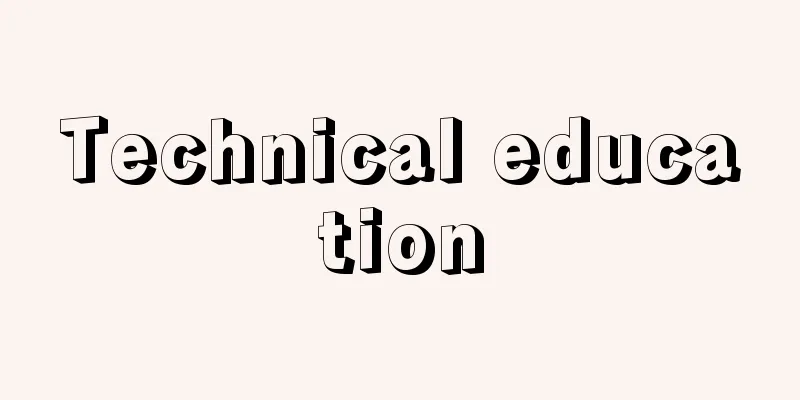Technical education

|
This refers to education aimed at acquiring knowledge and skills related to industrial technology. The beginning of technical education in Western EuropeThe apprenticeship system had long supported the transmission of techniques and skills, but the Industrial Revolution destroyed it. After the Industrial Revolution, workers themselves began to actively seek political and economic advancement, and in the early 19th century, the Mechanics' School movement was formed in England in conjunction with this movement. In France, attempts were made to create technical education institutions to replace the apprenticeship system, and in 1870, municipal apprenticeship schools were opened all over the country, starting with the Willet School in Paris, and measures were taken to train general workers (the upper echelons) in a school-like format. [Masatoshi Hara] The flow of technical education in JapanIn feudal times, handicraft production was carried out in privileged guild organizations such as "za" and "kabu nakama," and the passing on of skills was supported by an apprenticeship system. However, after the Meiji Restoration, a situation arose in which modern technology was rapidly introduced before the Industrial Revolution. In the early Meiji period, the Ministry of Education's immediate tasks were to establish higher education institutions to train bureaucrats and industrial officers, and to spread general education to the public. With regard to technical education, the "Gakusei" (promulgated in 1872) listed industrial, commercial, agricultural, and other schools as types of junior high school. The first full-scale secondary industrial education institution undertaken by the Ministry of Education was the Tokyo Vocational School (1881). The school aimed to train "those who would become instructors, foremen, and production managers at vocational schools," and had an apprentice training center attached to it. Meanwhile, in traditional industrial centers such as Kyoto, Kanazawa, Hachioji, Ashikaga, and Kiryu, study groups and seminars were organized from the end of the 1880s as new technologies were introduced, and these became the basis for secondary industrial education institutions from the 1890s onwards. The system was established with the establishment of the "Vocational Supplementary School Regulations" (1893), the "Simple Agricultural School Regulations" (1894), and the "Apprentice School Regulations" (1894), followed by the "Industrial School Regulations" and "Agricultural School Regulations," and the establishment of vocational and technical colleges with the "Vocational School Order" (1899) and "Technical School Order" (1903), which incorporated these. Originally, apprenticeship schools had different purposes; "apprenticeship schools were to provide the education necessary for craftsmen," while industrial schools were to "train people to become technicians, assistants, and factory clerks." However, the children of apprentices and craftsmen at the time could not afford to attend school, so many apprenticeship schools became substitutes for industrial schools and were used for primary industrial education before being abolished (1921). The expansion of higher education institutions in the 1920s led to a relative decline in the status of industrial school graduates, and practical training was required rather than theory, especially in the early 1930s during the Great Depression. However, as the Secondary School Act (1943) was enacted following the National School Act (1941), reforms to the secondary school system were implemented, and industrial schools were unified from the previous nearly 100 subjects to 15 subjects, including mechanical, electrical, and aviation. Of these subjects, the aviation department was abolished after Japan's defeat in the war, but the rest remained almost unchanged until 1951 (Showa 26). After the war, vocational schools became the three-year "vocational departments" of high schools, and their goal was to "foster the skills and knowledge necessary for those who would become mid-level skilled workers." The educational goals of technical schools and high schools have remained basically unchanged throughout the prewar and postwar periods. In other words, from the late 1920s to the early 1930s, and from immediately after the war until the 1950s, emphasis was placed on educating students to become "general labor leaders," "healthy factory managers," and "mid-level skilled workers," but in reality, the focus was on training elementary technicians. In the 1960s, under the "National Income Doubling Plan," technical high schools were greatly expanded, but coupled with the growing desire to go to university, the number of students moving on to general high schools was higher than expected. As a result, technical high schools began to have students with lower motivation and academic ability than before, and technical high schools in and around large cities began to produce dropouts. The "technological innovation" that came at the time required high levels of basic academic ability and specialized knowledge not only for elementary technicians but also for skilled workers. The increase in the number of five-year technical colleges established in 1961 and four-year university engineering departments, combined with the decline in the "ability" of technical high school graduates, led to technical high school graduates being excluded from jobs as so-called junior engineers. [Masatoshi Hara] Current state of technical educationUnder these circumstances, the idea of rejecting vocational education at the high school level spread in the form of the idea of a regional comprehensive high school. However, recent surveys have revealed that companies are looking to hire mid-level skilled personnel from technical high schools, and that many of these workers are engaged in the core tasks of the mechatronics era, such as information processing and repair and maintenance. The development of "technological innovation," centered on microelectronics, calls for the training of human resources who can be called "technical technicians" with a wealth of technical knowledge. As a result, in vocational training as well, the establishment of two-year specialized training courses (vocational training junior colleges) after high school graduation has begun in earnest. In addition, specialized courses at technical colleges (vocational schools) for high school graduates are expanding, particularly in the areas of information processing and electrical and electronics, and proposals are beginning to be made to extend the length of study at technical high schools (industrial departments). How the training of "technical technicians" and elementary engineers should be positioned within the overall education system is one of the major issues facing future education reform. [Masatoshi Hara] [Reference] |Source: Shogakukan Encyclopedia Nipponica About Encyclopedia Nipponica Information | Legend |
|
産業技術に関する知識および技能の習得を目的とする教育をいう。 西欧の技術教育の始め技術・技能の伝承を古くから支えてきたのは徒弟制度であったが、産業革命はそれを崩壊させた。産業革命後、労働者自身による政治的・経済的向上を目ざす運動が活発化するが、それらの運動と結合して19世紀初めには機械工講習所運動がイギリスでおこった。フランスでは徒弟制度にかわるべき技術教育機関の創出が試みられ、1870年にはパリのウィレット徒弟学校はじめ、各地に市立徒弟学校が開かれ、一般労働者(の上層部)を学校形態で養成する方策がとられた。 [原 正敏] 日本の技術教育の流れ封建時代、手工業生産は「座」「株仲間」など特権的なギルド組織で行われ、その技術の伝承は徒弟制度が支えた。ところが明治維新後、産業革命を経る以前に近代技術が急激に導入されるという状況が生じた。明治初期、文部省は、官僚と工業士官の養成のための高等教育機関の確立と国民への普通教育の普及を当面の課題とした。技術教育に関しては、「学制」(1872年公布)に工業・商業・農業などの学校が中学校の一種としてあげられている。 文部省が最初に取り組んだ本格的な中等工業教育機関は東京職工学校(1881)である。同校は「職工学校ノ師範若(もし)クハ職工長、製造長タルベキ者」の養成を目的とし、職工徒弟講習所を付置した。一方、京都や金沢、八王子、足利(あしかが)、桐生(きりゅう)など伝統工業の中心地では、1880年代末から新技術導入に伴い、研究会や講習会が組織され、1890年代以降の中等工業教育機関の基盤となった。「実業補習学校規定」(1893)、「簡易農学校規定」(1894)、「徒弟学校規定」(1894)に続く「工業学校規定」「農業学校規定」の制定、それらを包括する「実業学校令」(1899)と「専門学校令」(1903)に伴う実業専門学校の発足と、制度的に整備される。元来、徒弟学校は「職工タルニ必要ナ教育ヲ為(な)ス」ところ、工業学校は「技手、助手、及ビ工場事務員トナルベキ者ヲ養成スル」ところと、その目的は違っていたが、当時の徒弟や職工層の子弟には通学の余裕などなく、徒弟学校の多くは工業学校の代用となり、初等工業教育に利用され、結局は廃止(1921)された。 1920年代の高等教育機関の拡大は、工業学校卒業者の地位を相対的に低下させ、理論より実技の練磨が要請され、とりわけ大恐慌下の1930年代初頭にはそれが強調された。しかし日中戦争の拡大につれて状況は一変し、工業学校卒業者はおもに下級技能者として迎えられた。第二次世界大戦下、「国民学校令」(1941)に続いて「中等学校令」(1943)が公布され、中等学校制度の改革が進められ、工業学校も従来の100種目近い学科が機械・電気・航空など15科に統一された。これらの学科のうち、敗戦により航空学科が廃止されたが、ほかは1951年(昭和26)までほとんど変化しなかった。戦後、実業学校は3か年の高等学校の「職業に関する学科」となり、目標は「中堅技能工員となるべき者に必要な技能・知識を養成する」とされた。 工業学校・工業高校の教育目標は戦前・戦後を通じて基本的に変わっていない。すなわち、1920年代末から1930年代初めと、敗戦直後から1950年代にかけて「一般労務者ノ指導者」「健実ナ職工長」「中堅技能工員」となるべき教育が強調されたが、実質的には初級技術者の養成がその中心であった。1960年代、「国民所得倍増計画」のもとで工業高校が大拡張されたが、大学進学志向の高まりと相まって普通科高校への進学が予想以上となり、その結果、工業高校は、従来に比べて意欲・学力の低い生徒を抱えるようになり、大都市とその周辺の工業高校では脱落者を生む状況となった。おりからの「技術革新」は、初級技術者のみならず技能工にも高水準の基礎学力と専門的知識を要求した。1961年設置の五年制工業高等専門学校や四年制大学工学部の増大と工業高校卒業者の「実力」低下が相まって、工業高校卒業者は、いわゆる初級技術者としての職務からも排除されるようになった。 [原 正敏] 技術教育の現状以上のような状況のもとで、高校段階での職業教育否定論が地域総合制高校論の形で広がった。しかし近年の調査では、企業の中堅技能者要員の採用希望は工業高校卒業者に集中し、その職務も情報処理、修理保全などメカトロニクス時代の基幹的職務についている者が多いことが明らかになった。 マイクロエレクトロニクスを中心とする「技術革新」の展開は、技術的素養に富んだ「技術的技能者」ともいうべき人材の育成を要請している。その結果、職業訓練においても、高校卒業後2か年の専門訓練課程(職業訓練短期大学)の設置が本格化した。また高校卒業者を対象とする専修学校専門課程(専門学校)が情報処理科と電気・電子科を中心に拡大し、工業高校(工業学科)も修業年限の延長が提起され始めている。「技術的技能者」や初級技術者の養成を教育制度全体のなかでどのように位置づけるべきかが、今後の教育改革の一つの大きな課題となっている。 [原 正敏] [参照項目] |出典 小学館 日本大百科全書(ニッポニカ)日本大百科全書(ニッポニカ)について 情報 | 凡例 |
<<: Professional Engineer - Gijutsushi
Recommend
Chibu Red Cliffs - Chiburi Sekiheki
A sea cliff in the western part of Chifu Village, ...
Prison Rules and Diagrams
...In addition, exile that was scheduled for Hokk...
Antipatros - Antipatros (English spelling)
400BC - 319BC A general of the Kingdom of Macedoni...
Asahi Sadaemon Shigeaki - Asahi Sadaemon Shigeaki
…diary. Written by Shigeaki Asahi Sadaemon. 37 bo...
Measuring microscope
Length measurement within the field of view of a m...
determinative
…For example, the character shaped like the sun i...
Samuel Courtauld
1876‐1947 British businessman and patron of the ar...
Homophones - Douongo
Also called homophones. Taking into account the c...
Psychogenie
... is a psychiatric term referring to mental dis...
Mont Blanc (mountain) (English spelling)
The highest peak in the European Alps. It is 4,807...
Aurelia
A passenger car manufactured and sold by the Itali...
Hyogo dormitory - Hyogo Ryo
A military office in the Nara period. It is divid...
Rotational dispersion - Kaitenbunsan
[Synonym] Optical rotatory dispersion Source: Mor...
Soyang [town] - Soyang
This is an old town in Aso County, in the eastern ...
Valley (English spelling)
A depression between mountains. A small one is ca...









